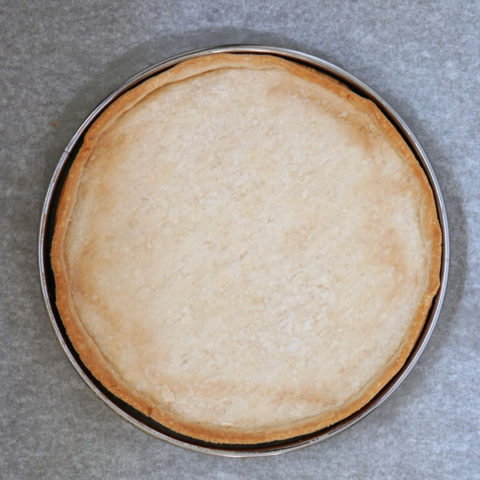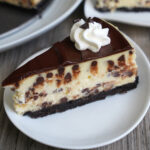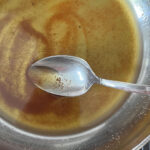What’s the right way to pre-bake a crust before filling it? This tutorial explains why and how you should blind bake a pie crust.

What Does Blind Bake Mean?
Blind baking basically means that you have to partially or completely bake the shell before adding your filling. The shell must be weighed down so that shell keeps its shape and prevents the dough from puffing up with air pockets.

What Kind of Pies Need to Be Blind Baked?
Any pie or tart that does not have a cooked filling should be blind baked. For example, a pastry cream filled fresh fruit tart or chocolate ganache tart would need to be blind baked. In addition, pies and tarts that bake quickly or use really low temperatures should also be blind baked. For example, a vegetable quiche would need to be blind baked because the egg mixture would cook before the pie crust and you would be left with a raw crust.
Popular Pies and Tarts that Require Blind Baking:
- quiche
- lemon meringue pie or lemon tarts
- pumpkin pie
- banana cream pie
- fruit tarts
- coconut cream pie

How to Blind Bake a Pie Crust with Weights
- Before you blind bake, line a pie pan or tart ring with chilled dough and shape your edges. Then make sure you chill your dough for at least 30 minutes.
- Optional: You may want to dock the dough by poking several holes in it with a fork. This is an extra precaution to prevent it from rising. However, if you plan to fill the shell with something more liquid such as a custard or quiche filling that needs to return to the oven, do not dock! You don't want the liquid seeping into the crust.
- Line the raw tart shell with a piece of parchment paper slightly bigger than the pie and fill it with pie weights.
- Bake the dough at 350°F (or the recipe’s recommended temperature and time) until lightly browned.
- Remove the weights and parchment paper and return the pie shell to the oven if it’s necessary to bake the shell all the way through.

What If I Don’t Have Parchment Paper?
You can also use aluminum foil. In fact, award winning Brave Tart author Stella Parks recommends foil because it’s not as stiff and you can press it all the way to the edges as well as let it hang over the crust to prevent the edges from burning.

What Can I Use in Place of Pie Weights?
Personally, I don’t own any pie weights. I keep a jar of mixed beans that I’ve collected from either them being too old or they didn’t fit in my storage jars after refilling from a bag. These seem to work just fine but here are some other alternatives to pie weights.
- Dry Beans- Place them over parchment paper or foil. You won’t be able to eat these beans but save them for your next blind bake!
- Rice- Place rice over parchment paper or foil.
- Sugar- Place it over foil or parchment. This may see odd but it does work as long as your blind baking temperature is not about 350°F. It also fills out the bottom of your pan better than beans. You can also reuse the sugar as a weight until it starts to turn pale brown.
- Nested pie plates- This trick works without having to use parchment paper or foil. However, it’s not the best option for a decorated edge because you will lose the design. Spray the bottom of a second pie plate and place it inside the first. (Make sure the crust is chilled in the pan). Turn the nested pans upside down over a sheet pan and then place it in the oven. Turning it upside down keeps the crust from shrinking.

Remember, for any of these options, you may need to return the shell to the oven for additional baking if the recipe requires a fully baked crust.

How to Blind Bake A Pie Crust
What’s the right way to pre-bake a crust before filling it? This tutorial explains why and how you should blind bake a pie crust.
Materials
- pie pan or tart ring
- tart dough
- parchment paper or foil
- pie weights- ceramic balls, dry beans, rice, or sugar
Tools
- rolling pin
Instructions
- Before you blind bake, line your pie pan or tart ring with chilled dough and shape your edges. Then make sure you chill your dough for at least 30 minutes.
- Optional: You may want to dock the dough by poking several holes in it with a fork. This is an extra precaution to prevent it from rising. However, if you plan to fill the shell with something more liquid such as a custard or quiche filling that needs to return to the oven, do not dock! You don’t want the liquid seeping into the crust.
- Line the raw tart shell with a piece of parchment paper slightly bigger than the pie and fill it with pie weights.
- Bake the dough at 350°F (or the recipe’s recommended temperature and time) until lightly browned.
- Remove the weights and parchment paper and return the pie shell to the oven if it’s necessary to bake the shell all the way through.
Notes
- Save your trimmed dough after lining the tart shell. If you end up with holes in the crust after blind baking, you can fill the holes with small pieces of raw dough if it's going back in the oven.
- You may need to return the shell to the oven for additional baking if the recipe requires a fully baked crust.



















Comments
No Comments